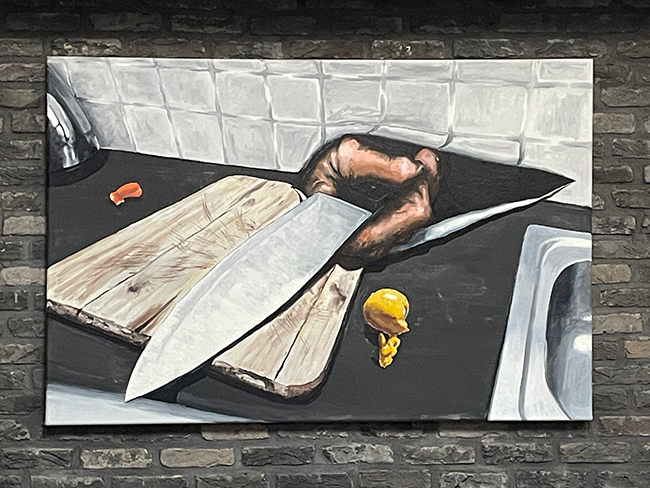Jakub Rehak, born in Prague in 1974, is an artist whose work challenges the boundaries of video, performance, and painting. Now based in Antwerp, Rehak’s artistic journey took shape at the Media Arts and Design Faculty in Hasselt, Belgium, where he studied Fine Arts. His multi-disciplinary approach reflects his deep interest in the emotional landscape of human experience. Rehak’s works draw from personal encounters, emotionally charged events, and broader reflections on the human condition, translating these into visual pieces that serve as “powerful windows,” often laced with subtle references to art history.

Rehak is also an educator, working at an academy for visual arts. Teaching alongside creating seems to complement his art, providing a space for exchange and exploration that influences his personal work. He explores themes like tension, duality, and the ambiguity of objects and actions, inviting viewers to engage with both the visible and the implied meanings in his work.
One of his oil on canvas paintings, Evaluation II (between kettle and sink), is an example of his reflective, layered approach. Created in 2017, the piece is currently on display at Kunsthalle Recklinghausen in Germany. The painting measures 120 by 80 cm and presents an object familiar to many—a knife. But as with much of Rehak’s work, the familiar is complicated and loaded with meaning. In this case, the knife is more than a simple tool; it becomes a symbol holding multiple identities at once.
Historically, knives have appeared in both everyday still-life paintings and scenes of violence. In still lifes, they were often painted as part of the routine of domestic life, helping to prepare meals and functioning as a neutral tool. But in other genres, particularly historical paintings, knives took on a darker role as weapons, instruments of destruction, or death. Rehak is aware of this duality and uses it to inform Evaluation II. He combines these two identities of the knife—the mundane and the violent—into a single image that holds both potentials simultaneously.
In the painting, a hand holds the knife. Rehak reveals that it is his own hand, slightly deformed as it is in reality. This detail adds a personal layer to the work, heightening the discomfort or ominous feeling that the image provokes. The knife, already symbolically loaded, becomes an extension of the artist’s body, a conduit for his exploration of tension and ambiguity.
Rehak’s approach to art often challenges the viewer to consider how objects or actions can carry multiple meanings, depending on context. A knife in a kitchen is a tool, but in another setting, it becomes something much more threatening. His works engage with these shifting interpretations, asking viewers to reconsider their assumptions about everyday objects or moments.
Beyond the knife, Evaluation II also fits into the tradition of domestic still life, a genre where simple, everyday items are made significant through their portrayal. But in Rehak’s hands, the genre becomes more complex. The domestic space—represented by the reference to a kettle and a sink in the title—hints at routine, but the presence of the knife and the artist’s deformed hand disrupt that routine, suggesting something darker lurking beneath the surface of normalcy.
While Rehak’s work often involves personal elements, it also opens up broader questions about the nature of objects, their uses, and how they are perceived in different contexts. His paintings and other works resist simple interpretation, instead offering layers of meaning that shift depending on how they are viewed.
His work continues to evolve, blending personal history with wider reflections on art and society. The tension between personal experience and broader historical or cultural references creates a dynamic space in Rehak’s art, one where the familiar becomes unsettling and the ordinary becomes extraordinary. His hand-holding the knife is not just a personal statement but also an invitation for viewers to confront the uneasy coexistence of comfort and danger, utility and violence.
As Rehak continues to explore the boundaries of video, performance, and painting, his work invites reflection on the multiple layers of meaning inherent in the world around us. Whether in a still life or a more abstract piece, Rehak’s art captures the complexity of human experience, merging the personal with the historical, the familiar with the threatening, and the mundane with the profound. His visual language is sparse yet emotionally charged, challenging viewers to engage deeply with the stories his works tell, even when they remain elusive or open-ended.

